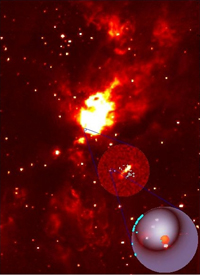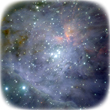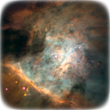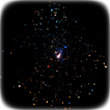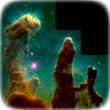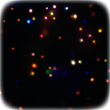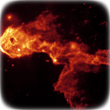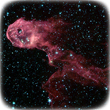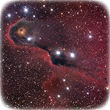The Case of the Massive Forming Star
Clues about the telescopes
 Image Courtesy of NASA/
Image Courtesy of NASA/ESA/STScI/ASU/J.Hester & P.Scowen.
The most important characteristics of a telescope are resolution and operating wavelength. A telescope with better resolution enables astronomers to make images that have finer details. All other things being equal, larger telescopes have better resolution than smaller telescopes. Operating wavelength refers to the type of radiation that a telescope’s mirrors reflect and focus. Optical telescopes manipulate light that has the colors of the rainbow. Radio telescopes collect microwaves—radiation with much longer wavelengths. In the universe, some phenomena produce optical radiation—such as stars and the ionized gas around them, as in the Orion Nebula—and some produce microwave radiation, such as the cold gas that lies in clouds in the deep space between stars.
The Hubble Space Telescope
The Hubble Space Telescope delivers optical images, using a mirror about 2 meters in diameter. It can resolve objects separated by as little as 0.05 seconds of arc on the sky—that is the size Superman standing in New York would report when a Chicagoan holds up a 12-inch ruler.
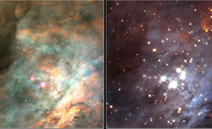 Image Courtesy of NASA and K. Luhman, Harvard-Smithsonian Center for Astrophysics
Image Courtesy of NASA and K. Luhman, Harvard-Smithsonian Center for Astrophysics
Very Long Baseline Array (VLBA)
The Very Long Baseline Array (VLBA) is the world’s largest telescope. It consists of 10 radio dish antennas, each 10 stories tall, distributed across North America, Hawaii, and the Caribbean. The VLBA can resolve objects separated by 0.0005 seconds of arc on the sky—that is thinner than the ruler would appear when held end-on. The VLBA performs like a telescope 8000 kilometers across.
